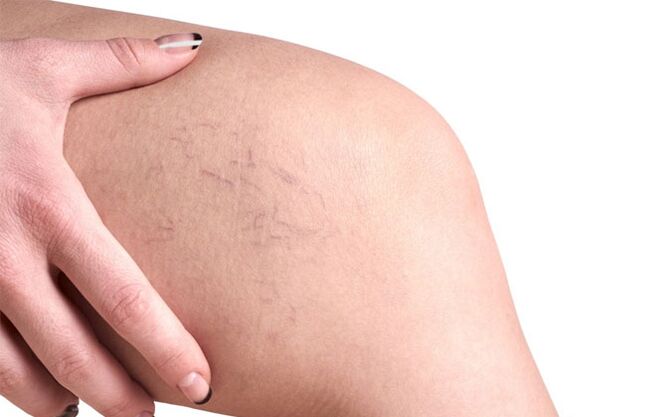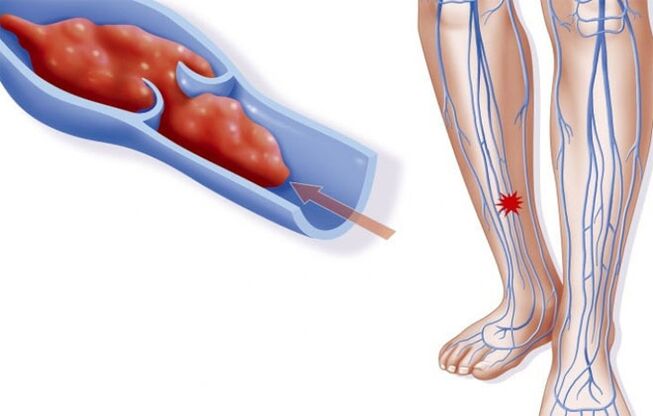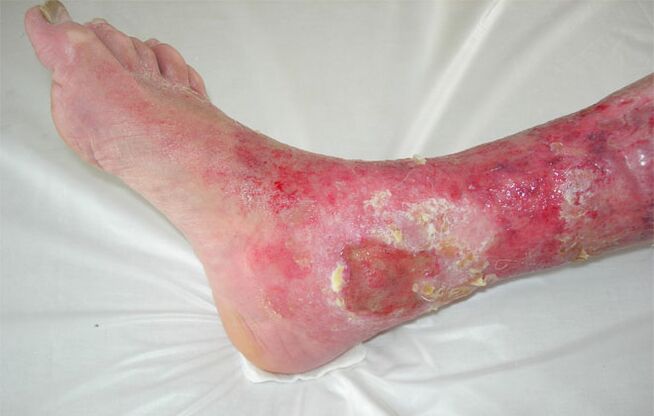Varicose vessels are called vascular disease, characterized by a violation of venous blood flow, thinning of veins, an increase in their lumen and pathological expansion.The vessels of the legs are most often affected.Mostly women get sick.The development of complications of varicose veins of the veins of the lower extremities is due to untimely or improper treatment.

Description of complications
With varicose veins, complications are local and common.The consequences of the disease can be:
- Faring syndrome.
- Phlebitis.
- Most often, hyperhidrosis of the affected limb (increased sweating) is observed.
- Clogging veins on a thrombus.
- The formation of trophic ulcers.
- Chronic venous deficiency.It is characterized by a violation of the process of venous blood.
- Varicose eczema.It develops as a result of the microbes under the skin and is characterized by inflammation of the surrounding tissues.The cause may be severe skin itching.Signs of eczema are redness of the skin, an increase in local temperature, burning, itching, peeling, swelling of the soft tissues and the presence of a bubble rash.
- Bleeding.
- The formation of non -pigmented atrophic plaques.
- Occlusion of the vessel.
- Erysipelas.
- Changing the color of the skin.
- Tissue seal (subcutaneous fat).
- Pulmonary artery thromboembolism.
Swelling
Edema is the most frequent complication of the disease.They can appear between 1 and 2 stages.Edema have the following distinctive features:
- In the early stages, they occur with a long stay in the standing or sitting position.This is due to the fact that the outflow of venous blood is difficult, which leads to an increase in vascular permeability.The plasma impregnates the wall of the vessel and goes into the surrounding fabrics, causing swelling.
- They are reduced in the person’s position lying.
- They arise mainly in the afternoon.
- The most severely expressed in the area of the legs.Office of ankles may occur.
- They are combined with heaviness in the legs, pain, itching, rapid fatigue and nightly convulsions.
- At the stage of decompensation, they become constant and do not disappear in a lying position.
- Are white and blue.Most often, with this disease, milk edema is observed.Blue edema indicate thrombosis and ischemia of tissues.Subsequently, with varicose veins, the skin of patients acquires a black hue due to tissue necrosis.
Phlebitis
The complications of varicose veins of the lower extremities include phlebitis.This is acute or chronic inflammation of the vein wall.The outer shell of the vessel is most often affected.The signs of phlebitis include soreness of the skin at the site of the vessel’s localization, the tension of the limb, redness and compaction of the skin, the presence of red stripes, the general malaise and an increase in body temperature.Chronic phlebitis proceeds with erased symptoms.

Thrombophlebitis
Terrible complication is thrombophlebitis.It is characterized by the presence of a thrombus (a blood clot) and the simultaneous inflammation of the vessel.Most often, only 1 limb is affected.Most often, this complication develops at 40-50 years.The manifestations of thrombophlebitis after varicose veins are chills, fever, bursting in the leg, swelling (after squeezing the tissues, deepening remains), cyanosis of the skin, palpation pain, local hyperthermia and swelling of surface veins.
Thrombosis
With varicose veins, thrombosis includes complications.With this pathology, a clot of blood forms in the lumen of the vessel, which is attached to the venous wall.A blood clot can block the lumen of the vessel, making the outflow of blood.The formation of a blood clot contribute to the slowdown of blood flow, the deficiency of the venous valves and the thickening of the blood.
Trophilic type ulcers
Against the background of violations of venous blood flow, tissue nutrition worsens.The skin becomes thinner and dense, which increases the risk of damage.In conditions of ischemia, even the slightest damage (scratches) can cause the formation of a trophic ulcer.These defects are also formed with tissue necrosis.Most often, ulcers appear with the expansion of veins complicated by chronic venous failure.

In most cases, the legs are affected.The appearance of an ulcer is preceded by atrophy of tissues, against which a deep defect is formed.At first it is superficial, but then it spreads to the subcutaneous tissue.Multiple defects can merge, forming large foci.Ulcers can be complicated by purulent skin damage, inflammation of the periosteum, arthritis and osteomyelitis.
Thromboembolism of the artery
The thromboembolism of the pulmonary artery is the most dangerous complication for varicose veins of the lower extremities.It occurs as a result of separation of a fragment of a thrombus and blockage of the main vessels.This condition is characterized by:
- shortness of breath;
- pallor of the skin;
- cough;
- inhibition of consciousness;
- sweating;
- increasing body temperature;
- falling blood pressure.
With pulmonary embolism, there is a high probability of death.
Venous bleeding
The cause of bleeding is the thinning of the vessel wall.With damage to surface veins, it is most often short.The blood is dark red and flows slowly.Additional symptoms are the pallor of the skin, a rapid heartbeat and adynamia.The most dangerous internal bleeding from deep veins.

How to avoid negative consequences
To avoid complications of varicose veins of the lower extremities, it is necessary to start treatment in a timely manner and adhere to a doctor's prescription.Self -medication is unacceptable.Therapy for varicose veins includes:
- Elimination of risk factors (refusal of smoking and alcohol, increasing motor activity, reducing static load, refusal of sedentary work, correction of body weight, normalization of hormonal background, refusal to lift weights, wearing high -heeled shoes and cramped linen, normalization of blood coagulation).
- Physiotherapy physical education (set of exercises).
- Normalization of food.In the diet of patients there should be products rich in vitamin C.
- Wearing compression linen.
- The use of folk remedies (compresses with bitter wormwood, infusions and decoctions based on herbs).For varicose veins, calendula, chamomile, a series, lemonnik, lemon balm and hawthorn are used.























